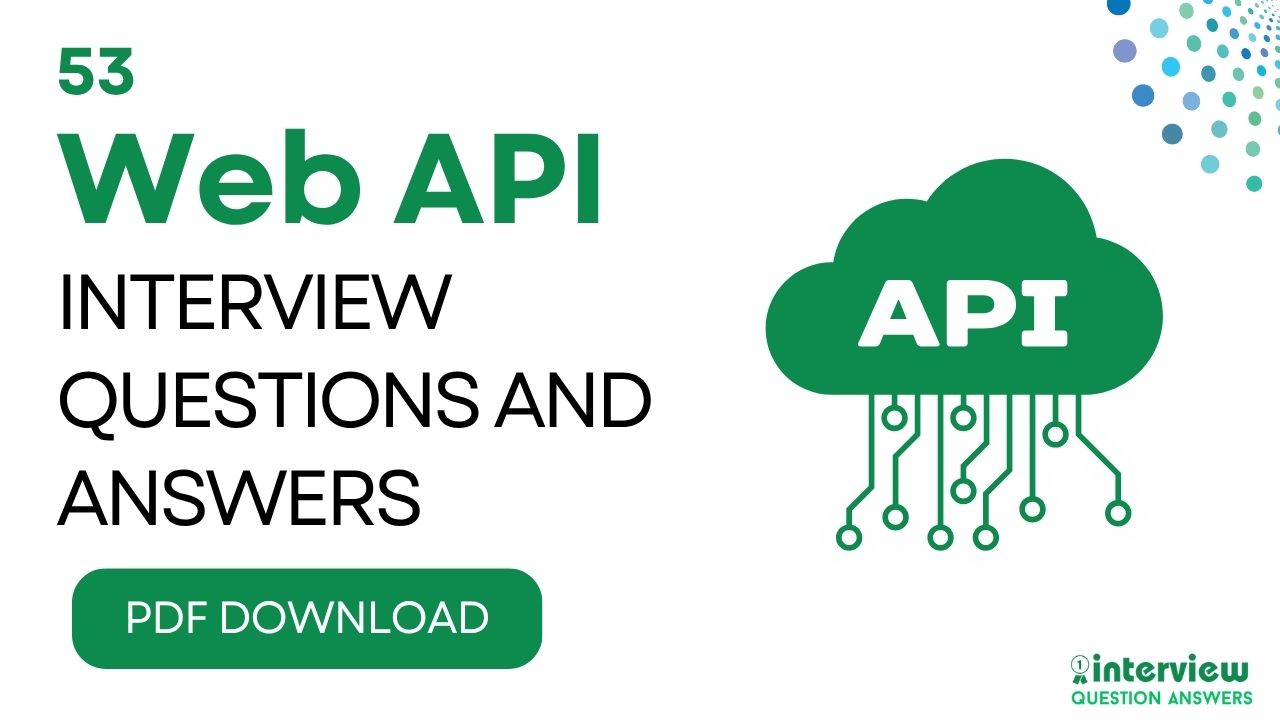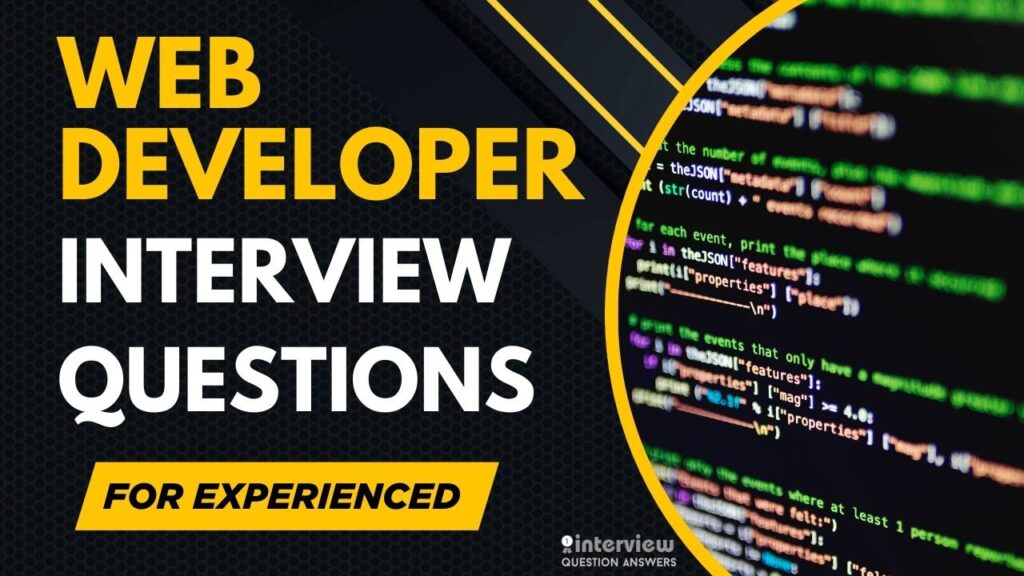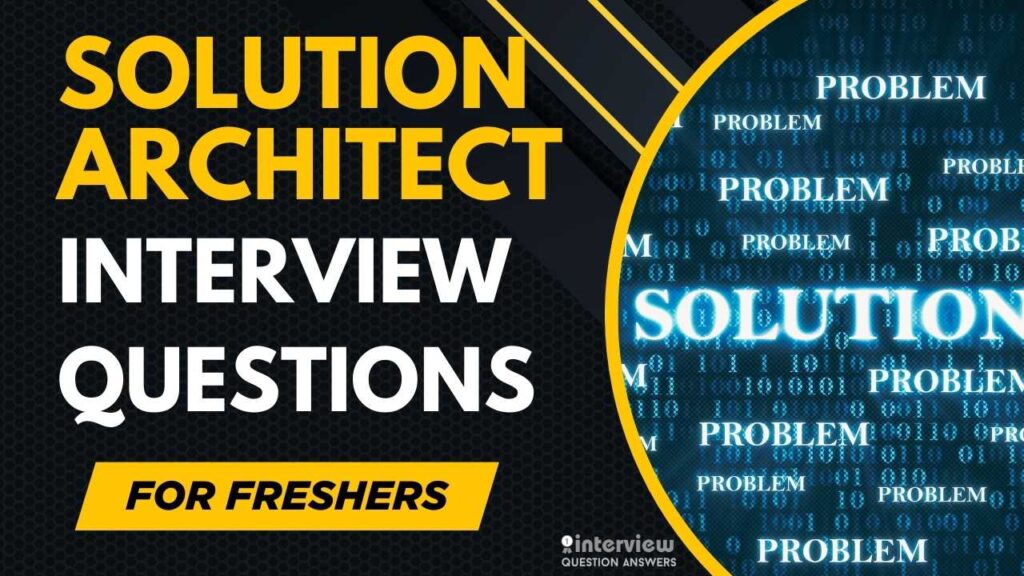Web API developers create and maintain the crucial communication pathways that enable different applications, systems, and services to interact seamlessly with each other. These professionals design RESTful services, implement authentication protocols, manage data serialization, and ensure secure data exchange between client applications and server databases.
Companies across all industries now rely heavily on API-driven architectures for mobile apps, web applications, and third-party integrations, making Web API expertise one of the most sought-after skills in modern software development.
Fresh graduates and experienced developers alike must demonstrate strong technical knowledge and practical problem-solving abilities to succeed in today’s competitive API development landscape.
This comprehensive interview guide delivers targeted questions and detailed answers specifically crafted for both fresher and experienced Web API developers. We focus extensively on ASP.NET and C# technologies, providing specialized questions that cover these dominant platforms in the API development ecosystem.
Table of Contents
Web API Interview Questions and Answers for Freshers
Que 1. What are the main differences between REST and SOAP Web APIs?
Answer:
- REST: Lightweight, uses HTTP, supports JSON/XML, stateless.
- SOAP: Protocol-based, heavy, uses XML only, supports advanced features like WS-Security.
Que 2. What is the difference between HTTP and HTTPS in Web APIs?
Answer:
- HTTP: Non-secure protocol, data is transferred as plain text.
- HTTPS: Secure version of HTTP, uses SSL/TLS encryption for data transmission.
Que 3. What are common HTTP methods used in Web APIs?
Answer:
- GET: Retrieve data
- POST: Create new resource
- PUT: Update resource completely
- PATCH: Update resource partially
- DELETE: Remove a resource
Que 4. What is the difference between PUT and POST in APIs?
Answer:
- PUT: Idempotent, updates the resource at a specific URL.
- POST: Creates a new resource, not necessarily idempotent.
Que 5. What are HTTP status codes and give examples?
Answer:
- 2xx: Success (200 OK, 201 Created)
- 4xx: Client error (400 Bad Request, 404 Not Found)
- 5xx: Server error (500 Internal Server Error)
Que 6. What is JSON and why is it used in APIs?
Answer:
JSON (JavaScript Object Notation) is a lightweight data-interchange format. It is used because it is easy to read, parse, and widely supported by programming languages.
Que 7. How do you test a Web API manually?
Answer: Use tools like Postman or cURL to send API requests, validate status codes, response data, headers, and performance.
Que 8. What is the difference between query parameters and path parameters?
Answer:
| Parameter Type | Example URL |
|---|---|
| Path Parameter | /users/101 |
| Query Parameter | /users?id=101&active=1 |
Que 9. What are headers in Web API requests?
Answer: Headers carry metadata about the request or response such as:
- Content-Type (e.g., application/json)
- Authorization (Bearer tokens)
- Accept (expected format)
Que 10. What is the difference between Authentication and Authorization in APIs?
Answer:
- Authentication: Validates user identity (e.g., username/password, token).
- Authorization: Determines user permissions (e.g., allowed operations/resources).
Que 11. What is CORS in Web APIs?
Answer:
CORS (Cross-Origin Resource Sharing) is a browser security feature that allows or restricts requests from different domains. APIs must enable CORS if accessed from other domains.
Que 12. What is the use of API keys?
Answer: API keys are unique identifiers passed in requests for authentication and to monitor API usage.
Que 13. What are Idempotent methods in Web APIs?
Answer:
- Idempotent methods can be called multiple times without changing the result.
- Example: GET and PUT are idempotent, but POST is not.
Que 14. How do you validate API response structure?
Answer: Use schema validation tools or frameworks to check fields, data types, and nested structures in the response JSON or XML.
Que 15. What is rate limiting in Web APIs?
Answer: Rate limiting restricts the number of API calls a user can make within a given time to prevent abuse and maintain server performance.
Que 16. How do you secure Web APIs?
Answer:
- Use HTTPS
- Implement authentication (OAuth, JWT)
- Validate input data
- Apply rate limiting
- Avoid sensitive data in URLs
Que 17. What is the difference between synchronous and asynchronous APIs?
Answer:
- Synchronous: Client waits for the server response.
- Asynchronous: Server processes the request in the background and responds later, often with callbacks or event notifications.
Que 18. How do you handle versioning in Web APIs?
Answer:
- URL-based: /v1/users
- Header-based: Use Accept-Version in headers
- Query parameter-based: /users?version=1
Que 19. What are Webhooks in the context of APIs?
Answer: Webhooks allow APIs to send real-time data to other applications by making HTTP POST requests to a specified URL when certain events occur.
Que 20. What challenges do you face while testing Web APIs?
Answer:
- Lack of UI to visualize results
- Handling authentication and authorization
- Validating complex data structures
- Managing dependencies between APIs
- Testing APIs in distributed microservice environments
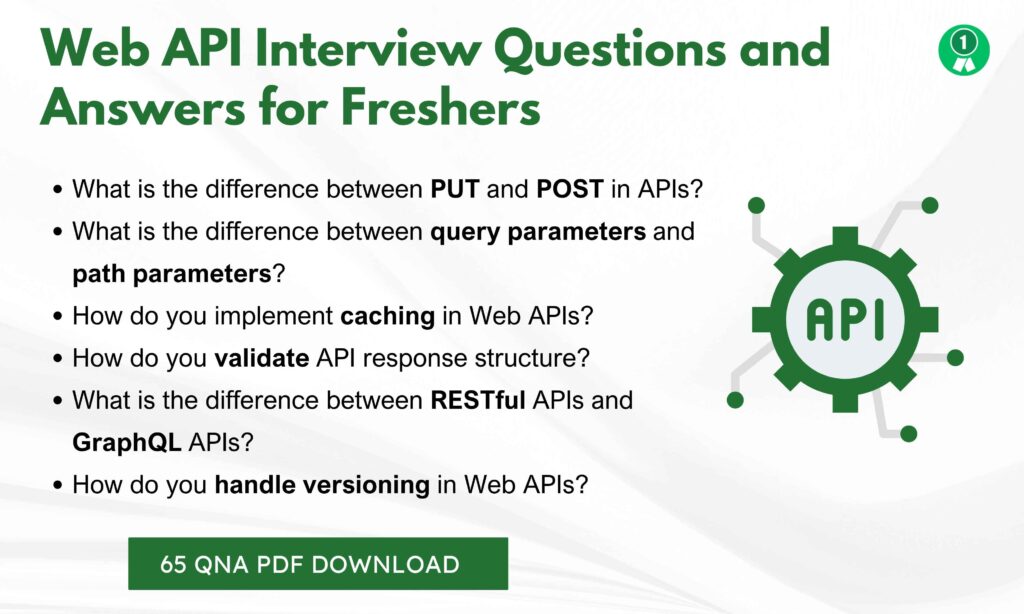
Also Check: Rest API Interview Questions and Answers
Web API Interview Questions and Answers for Experience
Que 21. What is the difference between RESTful APIs and GraphQL APIs?
Answer:
- RESTful APIs: Expose multiple endpoints for different resources, can lead to over-fetching or under-fetching of data.
- GraphQL APIs: Provide a single endpoint where the client specifies exactly what data it needs, reducing unnecessary data transfers.
Que 22. How do you implement caching in Web APIs?
Answer:
- Client-side caching: Use Cache-Control and ETag headers.
- Server-side caching: Store frequently accessed responses in memory (Redis, Memcached).
- Example:
Cache-Control: max-age=3600
ETag: "abc123"Que 23. How do you secure APIs using OAuth2?
Answer:
- Register the client application.
- Use Authorization Code or Client Credentials flow.
- Access tokens are issued and included in API requests using Authorization: Bearer .
Que 24. What is the difference between JWT and OAuth2?
Answer:
- OAuth2: Authorization framework for granting access tokens.
- JWT (JSON Web Token): Token format used to represent claims.
- JWT is often used as the token type in OAuth2.
Que 25. How do you handle pagination in Web APIs?
Answer:
- Offset-based: /users?offset=10&limit=20
- Cursor-based: /users?cursor=xyz&limit=20
- Cursor-based pagination is more efficient for large data sets.
Que 26. How do you monitor and log API performance?
Answer:
- Use logging frameworks (Serilog, ELK, Splunk)
- Implement performance metrics (latency, throughput)
- Integrate with APM tools like New Relic or Datadog for detailed insights.
Que 27. How do you manage API rate limiting and throttling?
Answer:
- Use gateways (Kong, Apigee, AWS API Gateway)
- Implement algorithms like token bucket or leaky bucket
- Return 429 Too Many Requests when limits are exceeded.
Que 28. What is the difference between SOAP Faults and REST error handling?
Answer:
- SOAP Faults: Predefined XML structure containing error details.
- REST Errors: Typically return JSON with error fields and proper HTTP status codes (4xx/5xx).
Que 29. How do you handle backward compatibility in APIs?
Answer:
- Use versioning (URL, header, or query parameters)
- Avoid breaking changes in existing endpoints
- Deprecate features gradually with proper communication to consumers.
Que 30. What are some common security vulnerabilities in APIs and how to prevent them?
Answer:
- Injection attacks: Validate and sanitize inputs
- Broken authentication: Use secure token management
- Data exposure: Use HTTPS and encrypt sensitive data
- Rate limiting: Prevent DoS attacks
Que 31. How do you implement HATEOAS in REST APIs?
Answer: HATEOAS (Hypermedia As The Engine Of Application State) includes links in API responses to guide clients to available actions.
Example:
{
"id": 1,
"name": "John",
"links": [
{"rel": "self", "href": "/users/1"},
{"rel": "orders", "href": "/users/1/orders"}
]
}Que 32. What are gRPC APIs and when would you use them?
Answer:
- gRPC uses HTTP/2 and protocol buffers for high-performance, strongly-typed APIs.
- Useful for internal microservice communication where speed and binary serialization matter.
Que 33. How do you validate large API responses efficiently?
Answer:
- Use JSON schema validation
- Stream large responses instead of loading fully in memory
- Validate only critical fields where applicable
Que 34. How do you design APIs for microservices architecture?
Answer:
- Ensure APIs are independently deployable
- Use service discovery and API gateways
- Favor asynchronous communication where possible (message queues, events)
Que 35. How do you test APIs for concurrency issues?
Answer:
- Perform load testing and stress testing using tools like JMeter or k6
- Validate race conditions with concurrent requests
- Ensure proper locking or idempotency
Que 36. What is an API Gateway and what are its responsibilities?
Answer:
- API Gateway is a single entry point for API requests.
- Handles routing, authentication, rate limiting, request transformations, and caching. Examples: Kong, Apigee, AWS API Gateway.
Que 37. How do you implement asynchronous APIs using Webhooks or Event-driven architecture?
Answer:
- APIs register a callback URL (Webhook).
- Server sends data/events to the callback URL asynchronously.
- Example: Payment gateways notify merchants when a transaction completes.
Que 38. How do you ensure idempotency in APIs?
Answer:
- Use unique request IDs for POST requests
- If the same request is retried, return the same result without duplicating operations.
Que 39. What is mutual TLS (mTLS) and how is it used in APIs?
Answer:
- mTLS requires both client and server to present valid certificates
- Ensures strong authentication and encrypted communication for APIs
Que 40. How do you design APIs for scalability and high availability?
Answer:
- Use stateless APIs so they can scale horizontally
- Implement load balancing and caching
- Deploy in multiple regions and use failover strategies
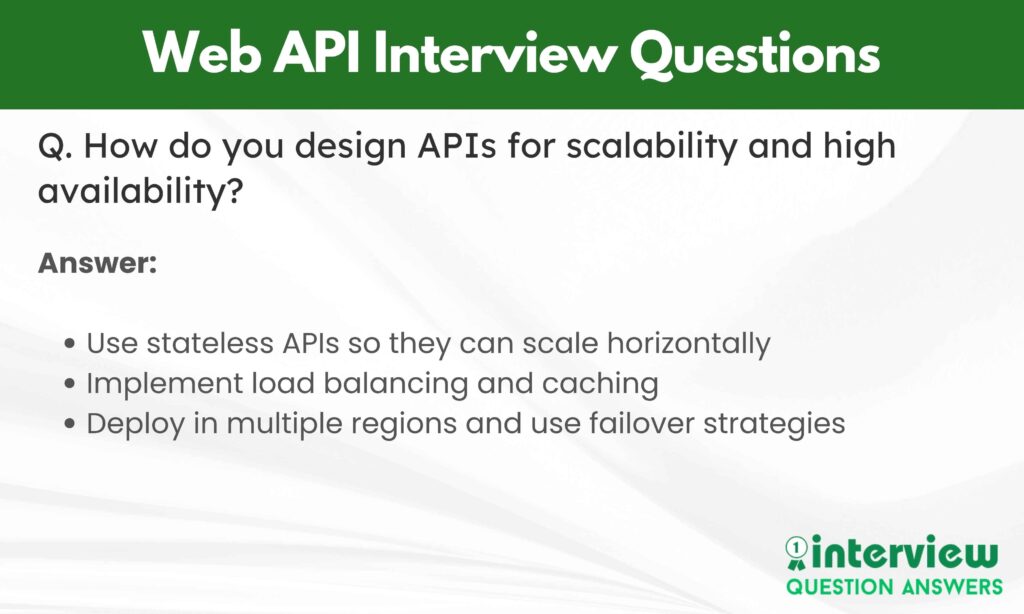
Also Check: API Testing Interview Questions and Answers
ASP.NET Web API Interview Questions and Answers
Que 41. What is the difference between ASP.NET Web API and WCF?
Answer:
- Web API: Designed for building RESTful services using HTTP, supports multiple data formats (JSON, XML).
- WCF: Can build SOAP-based services and supports multiple protocols (HTTP, TCP, Named Pipes).
Web API is lightweight and better suited for modern web/mobile applications.
Que 42. How do you enable attribute routing in ASP.NET Web API?
Answer:
Enable it in the WebApiConfig.cs file:
config.MapHttpAttributeRoutes();Then decorate controller methods with attributes:
[Route("api/products/{id}")]
public IHttpActionResult GetProduct(int id) { ... }Que 43. What are the different return types available in Web API controllers?
Answer:
- HttpResponseMessage
- IHttpActionResult (preferred for testability and flexibility)
- Strongly typed objects (which get serialized into the response format)
Que 44. How do you implement content negotiation in Web API?
Answer:
Web API automatically selects response format based on Accept headers (e.g., application/json). You can also force formats using Request.CreateResponse(HttpStatusCode.OK, data, “application/xml”).
Que 45. What are the differences between GET, POST, PUT, and DELETE in Web API?
Answer:
| Method | Purpose | Idempotent |
|---|---|---|
| GET | Retrieve data | Yes |
| POST | Create new resource | No |
| PUT | Update existing resource | Yes |
| DELETE | Delete resource | Yes |
Que 46. How do you handle exceptions globally in ASP.NET Web API?
Answer:
- Use Exception Filters (IExceptionFilter)
- Register GlobalExceptionHandler by inheriting ExceptionHandler
- Implement custom error responses in OnException method.
Que 47. How can you implement Dependency Injection (DI) in Web API?
Answer:
Use the built-in IDependencyResolver or integrate libraries like Unity, Autofac, or Ninject.
var container = new UnityContainer();
container.RegisterType<IProductService, ProductService>();
config.DependencyResolver = new UnityResolver(container);Que 48. How do you implement token-based authentication in Web API?
Answer:
- Use OAuth 2.0 with Authorization: Bearer headers.
- Generate tokens using OAuthAuthorizationServerProvider and validate using middleware or Authorize attributes
Que 49. How do you enable CORS in Web API?
Answer:
Install the NuGet package Microsoft.AspNet.WebApi.Cors and enable it in WebApiConfig.cs:
config.EnableCors();Then use:
[EnableCors("*", "*", "*")]
public class ProductsController : ApiController { ... }Que 50. What is the difference between synchronous and asynchronous controllers in Web API?
Answer:
- Synchronous: Blocks the thread until the operation completes.
- Asynchronous: Uses async/await, allowing better scalability and performance under high load.
Example:
public async Task<IHttpActionResult> Get() { await _service.LoadData(); return Ok(); }Que 51. How do you implement model validation in ASP.NET Web API?
Answer:
Use DataAnnotations attributes on models:
public class Product {
[Required] public string Name { get; set; }
}Validate in controllers:
if (!ModelState.IsValid) return BadRequest(ModelState);Que 52. What is OWIN and how is it used in Web API?
Answer:
- OWIN (Open Web Interface for .NET) decouples the web server from the application.
- Used for self-hosting Web APIs and building custom pipelines using middleware (e.g., authentication).
Que 53. How do you secure a Web API using HTTPS?
Answer:
- Configure SSL binding in IIS or Kestrel.
- Add [RequireHttps] filter or redirect HTTP to HTTPS in middleware.
Que 54. How can you return custom HTTP status codes in Web API?
Answer:
Use Request.CreateResponse() or ResponseMessageResult:
return Request.CreateResponse(HttpStatusCode.Created, product);Que 55. How do you host ASP.NET Web API outside of IIS?
Answer:
Use Self-hosting with HttpSelfHostServer or host via OWIN/Kestrel in console or Windows services:
var config = new HttpSelfHostConfiguration("http://localhost:8080");
using (var server = new HttpSelfHostServer(config)) { server.OpenAsync().Wait(); }Web API C# Interview Questions and Answers
Que 56. What are the differences between ASP.NET Web API and ASP.NET MVC?
Answer:
- Web API: Used to create RESTful services that return data (JSON/XML).
- MVC: Used to render views (HTML) for user interfaces.
- Web API can return content to a variety of clients (mobile, web apps), while MVC is typically used for server-side rendered UI.
Que 57. How do you implement routing in Web API C#?
Answer:
- Convention-based routing: Defined in WebApiConfig.cs:
config.Routes.MapHttpRoute(
name: "DefaultApi",
routeTemplate: "api/{controller}/{id}",
defaults: new { id = RouteParameter.Optional }
);- Attribute routing:
[Route("api/products/{id}")]
public IHttpActionResult GetProduct(int id) { ... }Que 58. What is the difference between IHttpActionResult and HttpResponseMessage?
Answer:
- IHttpActionResult: Provides cleaner and testable code, introduced in Web API 2.
- HttpResponseMessage: Gives full control over the HTTP response.
Example:
public IHttpActionResult Get() => Ok(data);
public HttpResponseMessage Get() => Request.CreateResponse(HttpStatusCode.OK, data);Que 59. How do you enable Dependency Injection in Web API C#?
Answer:
Use IDependencyResolver or third-party containers like Autofac or Unity:
var container = new UnityContainer();
container.RegisterType<IProductService, ProductService>();
config.DependencyResolver = new UnityResolver(container);Que 60. How do you handle exceptions globally in Web API?
Answer:
- Implement a custom ExceptionHandler by inheriting from ExceptionHandler.
- Use Exception Filters with IExceptionFilter.
- Register the filter in WebApiConfig.cs:
config.Filters.Add(new CustomExceptionFilter());Que 61. What are the main differences between GET and POST in Web API?
Answer:
| Method | Purpose | Idempotent | Data Location |
|---|---|---|---|
| GET | Retrieve information | Yes | Query string/URL |
| POST | Create resource | No | Request body |
Que 62. How do you implement token-based authentication in Web API?
Answer:
- Generate tokens using OAuth2 and return them to the client.
- Send tokens with each request using the Authorization header:
Authorization: Bearer <token>- Decorate controllers with [Authorize] attributes.
Que 63. How do you secure a Web API with HTTPS?
Answer:
- Install and configure an SSL certificate in IIS or Kestrel.
- Redirect all HTTP traffic to HTTPS.
- Enforce HTTPS using [RequireHttps] filter or middleware.
Que 64. How do you return custom HTTP status codes in Web API?
Answer:
Use Request.CreateResponse() or StatusCode() helper:
return Request.CreateResponse(HttpStatusCode.Created, data);or
return StatusCode(HttpStatusCode.NoContent);Que 65. How do you host a Web API in a console application using OWIN?
Answer:
WebApp.Start<Startup>("http://localhost:8080");In Startup.cs::
public void Configuration(IAppBuilder app)
{
HttpConfiguration config = new HttpConfiguration();
config.Routes.MapHttpRoute("DefaultApi", "api/{controller}/{id}", new { id = RouteParameter.Optional });
app.UseWebApi(config);
}Also Check: C# Interview Questions and Answers PDF
Web API Interview Questions PDF
we have added all questions and answers to a PDF below, that enables offline preparation and convenient practice sessions anytime.
FAQS: Web API Interview Questions
What is the typical job role of a Web API developer?
A Web API developer is responsible for designing, building, and maintaining APIs that enable communication between software applications. They work on RESTful services, data exchange, authentication, and integration with external or internal systems.
What challenges can one face in a Web API development job?
Common challenges include handling security (authentication, authorization), managing versioning without breaking existing clients, ensuring scalability and performance, dealing with large datasets, and maintaining backward compatibility in microservice environments.
What challenges might candidates face during a Web API interview?
Candidates may be asked scenario-based questions on real-world problems such as designing scalable APIs, implementing token-based security, handling error responses correctly, and optimizing performance. They may also face live coding tests or debugging exercises.
What is the average salary of a Web API developer in the USA?
The average salary for a Web API developer in the USA ranges from $90,000 to $120,000 annually. Senior-level developers and architects can earn upwards of $130,000 to $150,000, depending on their experience and location.
What key skills are required for Web API roles?
Proficiency in C# or other programming languages, strong knowledge of RESTful principles, hands-on experience with ASP.NET Core Web API, authentication mechanisms (OAuth2, JWT), versioning, and CI/CD tools are essential. Understanding microservices, cloud platforms, and API gateways is also beneficial.
Which companies hire Web API developers?
Top companies include Microsoft, Amazon, Google, Meta, Salesforce, Accenture, TCS, Infosys, Cognizant, and major fintech and healthcare organizations. Many startups and SaaS companies also have a high demand for skilled API developers.
How can one grow their career as a Web API developer?
To grow, developers should focus on advanced skills like API security, distributed systems, cloud-native development, and API design patterns. Transitioning to roles like Solution Architect, Tech Lead, or full-stack developer can also accelerate career growth.
Conclusion
Master Web API interviews with our Top Questions and Answers guide covering ASP.NET and C# expertise. Our targeted questions prepare both freshers and experienced developers for real-world scenarios.

